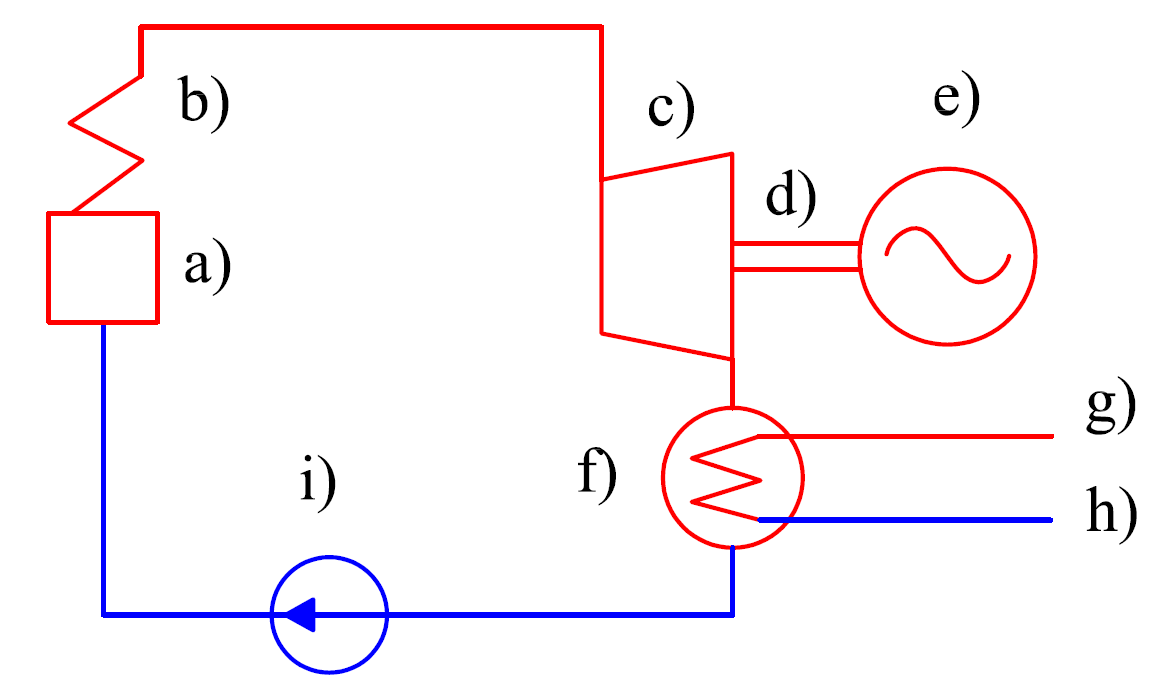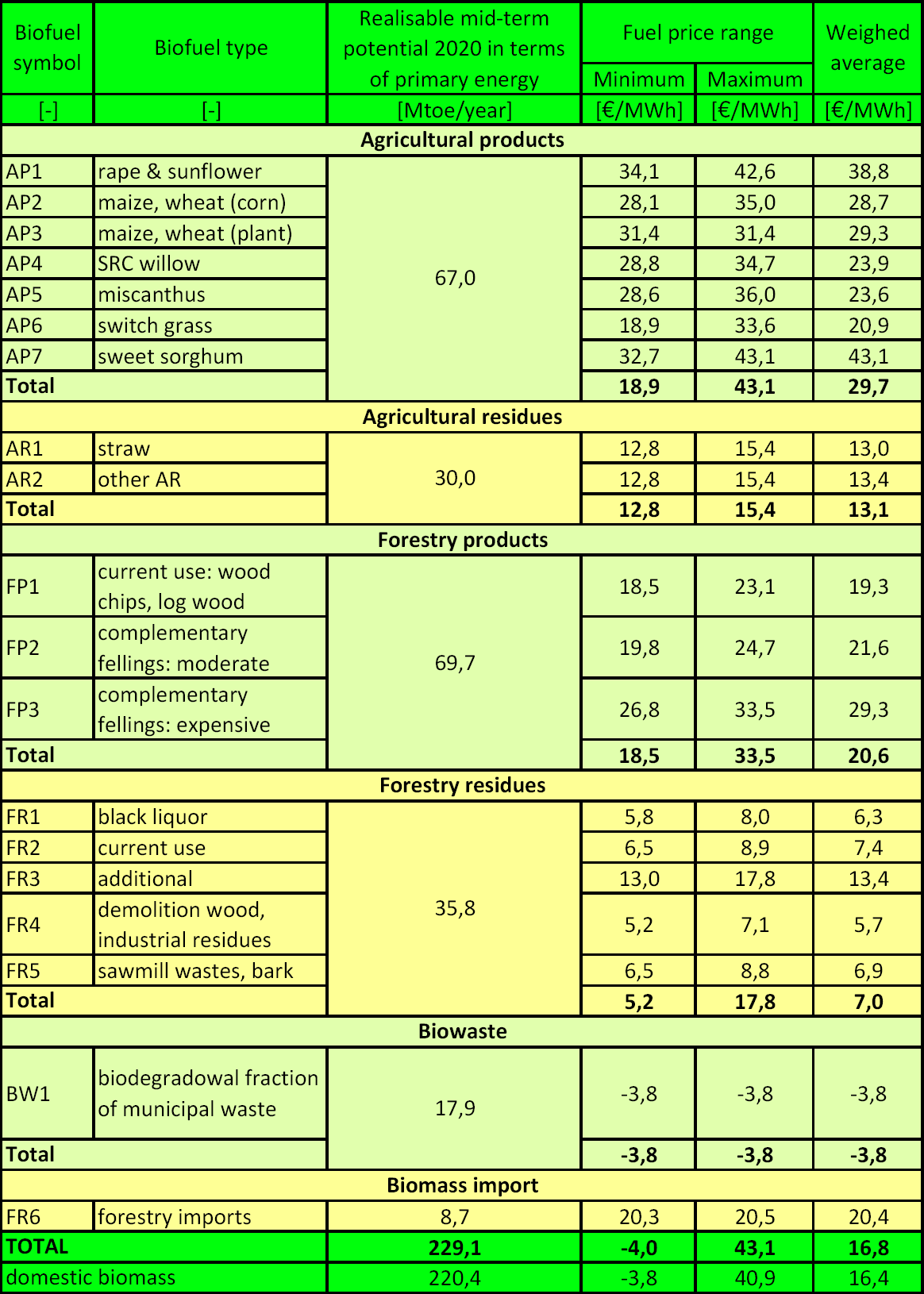
BIOMASS COMBUSTION
Bio-mass can be used as a solid fuel to heat and to generate electricity in typical Rankine cycle. Combustion is the easiest way to extract energy from bio-mass and convert it into electricity in final stage. During combustion the chemical energy of bio fuel are converting into the heat and pressure of steam in heat exchanger. After them, the steam drives turbine which is connected with generator by a shaft. Following figure shows simple Rankine cycle. (Fig. 43).[48]

Types of biomass and average prices
Wide range of biomass resources can be used as a fuel however average energetic value of biomass is lower than hard coal (about 30MJ/kg) or lignite (about 20MJ/kg) and equals about 10MJ/kg. All biomass categories and their price are described in below figure: (Fig. 44)[51]

Energy extracting methods
There are several methods of biomass combustion: only solid biomass combustion (for electricity only or Combined Heat and Power – CHP), co-firing biomass with solid fossil fuels (for electricity only or CHP) and waste incineration (for electricity only or CHP). All of them are below described: [43], [48]
- Solid biomass combustion
Direct combustion of biomass is the oldest method. Solid biomass is the only one fuel used in that process and can be combust in a dedicated power plants or in power plants which has used other solid fuels like coal. The heat energy can by extract by a furnace (only for heat generation) or power boiler (currently the most common solution to obtain electricity). Efficiency of that first stage of electricity production is about 60-80% of total biomass energy. However final product – electrical energy is about 26 – 30 % of combust biomass energy. One of the factors which have impact on the efficiency is type of boiler. At present there are following construction solutions: pile burners, stationary or travelling grate combustor and fluidized-bed combustor. Typical power plant size is in wide rage from 1MW to 25MW. [43], [48], [50] Major parts of the pile burner are a stationary grate and two combustion chambers (upper and lower). The grate is installed in lower chamber where the fuel is combust and emits warm volatile gasses. The gasses flow to the upper chamber and pass heat energy to steam by a heat exchanger. The automated ash removal system periodically removes ash. [50] Operating principle of stationary and travelling grate combustors are similar. An automatic feeder distributes the fuel onto grate. Under the great there are a pit (in stationary grate combustor) or a hopper (in travelling grate combustor) to collect the ash. [50] The fluidized-bed combustors the newest technology and consist in fuel combustion in a bed of granular material which flows as a boiling water under the influence of are injection into the bed. That solution allows to operate in low temperature (about 900°C) with relatively low NOx emission. and to combust high-ash fuels like biomass. [50] In fact only the fluidized-bed combustor may operate on biomass only. Obviously other technologies can extract energy from biomass however during combustion bio-fuels absolve potassium and sodium what is harmful for combustor thus it increase operation and maintenance costs. [50] Currently when that technology is not established so much in most of power plants, the largest recipient of biomass are residents who uses it to heat their own houses.
- Co-firing
This is second method of biomass combustion and also the most common. Since the EU established punishment for CO2 emission above founded limits, countries like Poland have big problem. Above 90% of total polish electricity generation is from fossil fuel (mostly from hard coal and lignite). Biomass co-firing is one of the major methods to avoid penalty. Moreover most of polish coal power plants have stationary or travelling grate combustors and there is no possibility to substitute coal. Co-firing is also profitable solution in countries which does not have problem with the GHG emission. Combusting biomass as a second fuel in a coal-burning power plants provide to reduction of sulphur dioxide and nitrogen oxide emission. To improve efficiency of co-firing operation biomass is preparing or boilers are modified for a new fuel. Due to low biomass prices provide to decrease operation costs and to increase “green energy” generation what is related with economic boosts like e.g. green certificates. Total efficiency of generation process is about 37%. [48], [50]
- Waste incineration
Wastes are the next solid biomass fuel. Rough waste fuel is not valuable however after preparing it becomes full valuable biomass fuel. Currently solid waste generally are stored on landfills and burned in garbage incinerators which does not have enough proper exhaust gas cleaning systems and emits a lot of air pollution. Therefore waste incineration in power plants is related with plenty of benefits. Waste fuel price generally consist of transport costs and rubbish preparation only. Landfills are overloaded and waste combustion is a solution to eliminate trashes. Currently power plants usually have well developed exhaust gas cleaning systems thus does not emits air pollution. Because wastes are also the biomass therefore incineration reduces the GHG emission. However wastes generally are used in other electricity generation process, in gasification (described in the next chapter). Average efficiency of power generation in waste incineration process is fluctuate between 18% and 22%. Typical size of power plant is in wide rage from 2MW to 50MW. [48], [50] Unfortunately biomass combustion decrease power unit efficiency. The most considerable in case of biomass combustion only as a fuel and in waste incineration. To avoid that reduction, power plants often operate in combined heat and power system (CHP). That solution use steam energy in turbine output to heat water which can be use to heating. It increases power unit efficiency by heat energy equals 63% - 66% in case of biomass plant, to 60% for co-firing and to 64% -66% for waste incineration. [9], [48] However biomass combustion has also disadvantages. The major is relatively low energy density and annual fuel availability. Unfortunately unprocessed biomass contains less energy than fossil fuels like coal and is not available during whole year. It is because green wood in about 50% consist of water. Therefore it can not be transported in longer distance than 50-100 km by truck. That transport limits caused also fuel amount limits and caused biomass energy system smaller that fossil. Obviously this is motivation for small regional biomass power systems development however this is serious disadvantage for large scale power plants. Thus raw biomass should be processing into pellets which have more energy density, are easier to transport in long distances and to storage. That solution also eliminate availability problem. [48]
-
Description of technology|
Economic aspects|
Environment and public awareness|
Legislation|
Final comparison|
References

